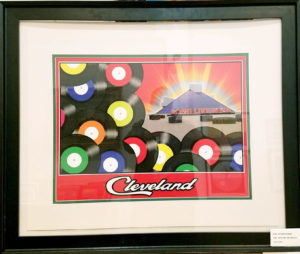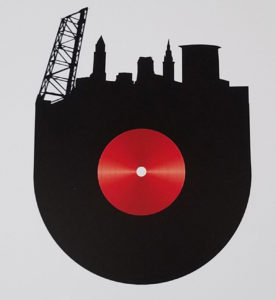
By Ricardo Colon
After doing some research, I discovered that there are few Latinos musicians that have been inducted in The Rock and Roll Hall of Fame. Carlos Santana in 1998 and in 2001 inductee Ritchie Valens.
Latinos’ roots in rock music go back into the 1940s, with figures like Lalo Guerrero, who mixed boogie and jump blues to create his patented Pachuco music, pioneered sounds similar to that of rock and roll.
It wasn’t until Ritchie Valens (born Richard Valenzuela) hit it big with “Donna” and “La Bamba” (and sadly, his tragic death alongside Buddy Holly and the Big Bopper) that the doors opened for Latinos to make rock and even more exciting. The late 60s and early 70s gave Latinos the freedom to use their birth names and sound to add favor to music being created during that time. With this new found feeling of acceptance they were playing music they created without fear of being painted into a corner as that Spanish music sound. Some say that was due to the impact of Carlos Santana and Jose Feliciano made in the mainstream music scene.
The influenced Latino sounds in rock and roll started when they joined the hippie bands at Woodstock, giving Latino American bands a chance to share their repertoire of music that translated well into rock and roll music. That combination came to life and made famous with Carlos Santana, a living legend and the ambassador of rock and roll. Latinos were there early in the creation of rock music, but their great history is untold especially by the Rock hall of Fame and Museum in Cleveland Ohio.
The Latino population in the United States has reached nearly 60 million, blacks 40 million and Asian around 20 million. The Latino influence in Rock and roll is well known but you wouldn’t know this by going to Cleveland’s Rock hall of fame and Museum.

The band Latin Explosion, became known for the famous Spanglish countdown that was in the style of Sam the Sham and the Pharaohs’ early rock sound, and there couldn’t be a better intro/opening band than Domingo Samudio (who took the name Sam The Sham)and who gave us “Wooly Bully,” or “Bule Bule,” translated, one of the best rock songs in history, and it’s about Samudio’s the cat of all things.
There are many more examples of unsung Latino rock pioneers that have not been recognized in the Rock and Roll of Fame.
The Rock and Roll Hall doesn’t understand that Latinos are some of the biggest fans of Rock and Roll. Groups like the Beatles, Rolling Stones, Jerry Garcia’s Grateful Dead and led Zeppelin are sold out at Latino venues throughout the world in places like California, Texas, Chicago, New York, San Juan Puerto Rico and throughout Spanish speaking countries like Mexico.
The staff and its board members of the Rock and Roll Hall of Fame would serve themselves well to learn more about Latinos role in the creation of Rock and Roll in America
Latinos throughout Northeast Ohio are not connecting with the events or exhibits going on at the Rock Hall of Fame because they do very little outreach throughout Northeast Ohio Latino community.
This is not surprising because they are not making a real effort to connect with the Latino media outlets throughout Northeast Ohio. I’m sure you will not see very many Latino media outlet: if any, at their induction event. We know that in Cleveland, the Latino media outlet rarely see any marketing efforts by the Rock and Roll Hall of Fame and Museum. It sad to see one of the largest and fastest growing ethnic group in the US being over looked perhaps be by design because you don’t see very many Latino artists who have contributed in so many ways to the success of Rock and Roll.
Not too long-ago the Rock and Roll Hall of Fame did away with Celebrating National Hispanic Heritage Month. Latinos are wondering why they did away with this important Hispanic Celebration month honoring Latinos contributions to the history of America music.
When asked why, a staff member stated we are no longer doing a National Hispanic Heritage Month event at the Rock Hall in Cleveland we in the future can do something with Latinos as part of some world event at the Rock Hall of Fame.
The Rock and roll Hall of Fame and Museum and the staff are missing the opportunity to highlight the great contribution Latinos make to this great country and to the history and formation of rock and roll music.

Perhaps a good idea would be for the Rock Hall of Fame and Museum to do some a special exhibit on how Latinos who have contribute to the history of rock and roll. This exhibit can highlight Latinos like Linda Ronstadt, Carlos Santana, Ritchie Valens and Jerry Garcia.
Also, here are some unsung rock pioneers you might not know like: Rudy Martinez, one of rocks crazy characters, so much so he changed his artistic name to a punctuation symbol. Still, he’s a genius who gave us the organ-drenched “96 Tears,” birthing one of the first punk songs in history and influencing fellow Michigan hooligans like Iggy Pop.
Another young talented Latino who name of was Danny Flores but went under the alias of Chuck Rio, was the feature and signature sax riff. Flores’ deep voice enunciating the name of the famous Mexican liquor. It was recorded as a B-side in 1957. In 1958, it outsold the song on the flip side of the single; in 1959, it won a Grammy, and hasn’t stopped playing somewhere in the world ever since.
It hard to believe that the Rock and Roll hall of fame can’t see the influence Latinos and Latino music made to rock and roll. The Latino sounds have had an influence on Rock and Roll from the beginning. That is why I have prepared a list of some of the great Latino musicians who had a great impact on Rock and roll music. I’m sure that there are many more Latino musicians who have impacted Rock and Roll. Here are more Latinos musicians who I’m sure you will recognize and who has also impacted the history of American music’
No one made us want to mambo more than the late Tito. The Harlem-born Puerto Rican musician was nicknamed the King of Timbales for his outstanding longevity behind the drums and his energetic aura onstage. The musical prodigy perfected his masterful skills at Julliard School of Music and was known for his fusion of Afro-Caribbean beats and jazz rhythms. During his career that spanned over 50 years, Puente won six Grammy Awards for his albums including “Best Latin Performance” for “Mambo Diablo” and “On Broadway.” He won the Grammy Lifetime Achievement a few years after his tragic death in 2000.
Hail to the Queen of Latin Pop! The legendary singer is known for her energetic performances and heart-hitting lyrics. With over 32 million albums sold in the U.S. alone, Gloria’s Miami Sound Machine days helped carve the way for many Latin pop stars to date. Estefan’s hit album, Mi Tierra, which paid homage to her Cuban roots, won the Grammy Award for “Best Tropical Latin Album” in 1993. She has won 3 Grammys and 4 Latin Grammys throughout the years, and we love her for it! what other notable Latino-American acts are missing from the Hall of Fame?
Blessed with a soft, but powerful angelic voice, Marc Anthony managed to go from the New York underground scene to international stardom in just a few years. The 43-year-old singer from the Bronx sings lyrics that embody the meaning of romance and all of its well-rounded failures and triumphs. He has won 2 Grammys, three Latin Grammys, and sold over 12 million copies worldwide. Nothing says I’ve-reached-icon-status more than his album “Iconos,” which features covers of all of ‘the greats’ including Juan Gabriel and José José. Whether it’s a simple ballad or an upbeat song, Anthony will always keep us earning for more.
For nearly six decades, Celia Cruz’s profoundly soulful voice and colorful presence revolutionized salsa and transformed her into a musical legend. The Cuban singer taught us that ‘life is a carnival’ (in one of her many hits “La Vida Es Un Carnaval”) and its rhythmic course should be danced to. Cruz’s powerful vocals were often featured alongside infectious piano cords and conga beats, and won her countless of accolades including three Grammys, four Latin Grammys, and twenty-three gold albums. The Queen of Salsa may have lost her battle against cancer in 2003, but her strong melodies and signature saying, “¡Azúcar!” will never be forgotten.
She graduated from the teen pop era, and blasted into the pop scene with full force. The Grammy-winning sensation mesmerized audiences at an early age with her heavy vocals and instant star power. A few years later, she proved she was a crossover pop diva with her hit Spanish album, Mi Reflejo. For her fourth album, Stripped, Christina got a little “Dirrty” and expressed her sexuality with full force. After three more studio albums, Back to Basics, Bionic, and Lotus, Aguilera has continued to prove that she’s one of the best voices of our generation.
Besides proving that her “Hips Don’t Lie,” Shakira has become one of Latin pop’s biggest female crossover stars thanks to her unique hybrid of pop, rock, and Middle Eastern influences. The Colombian singer has won a total of seven Latin Grammys and two Grammys including “Best Latin Pop Album of the Year” for her “Shakira: MTV Unplugged” album. Forbes may have deemed the “Waka Waka” singer the fourth top-earning female musician in history, but the generous 35-year-old is known for giving back to her community through her foundation Pies Descalzos. In 2011, Shakira was added to The Hollywood Walk of Fame after selling an estimated 70 million albums worldwide. Now that’s something to sway your hips to!
Born in Puerto Rico but raised in the U.S., Tito Nieves (born Humberto Nieves) began his career while participating in Cimarron, a New York-based orchestra. He then teamed up with Héctor Lavoe in 1977 and joined Conjunto Clásico soon after. Nieves started his solo career in 1986, setting himself apart by singing salsa in English. He became a chart-topper in 1997 with a song called “I Like It Like That.”
” Among his key albums are 1988’s Classic, 1989’s Yo Quiero Cantar, 2004’s Fabricando Fantasias, and 2006’s Hoy, Manana y Siempre, followed a year later with Pura Salsa Live, and 2008’s tribute offering Canciones Clasicas de Marco Antonio Solis, which landed at number 15 on Latin Heatseekers and 23 on the Top Latin albums charts. Nieves reached number 15 at Top Latin Albums and number two on the Tropical Albums hit list.
Over the years, the 64-year-old singer and composer has earned his title as an icon in the Latin jazz genre. His love for his roots also shined through when he wrote, “Patria,” which is considered the second national anthem for many Panamanians. He has produced over 40 albums since the 1970’s and continues to be a major influence in Latin music to date.
I’m sure I’m missing so many more but at least I’m trying to help you correct something very wrong with the Rock hall of Fame and Museum the lack of great Latinos musicians who have impacted Rockin and Roll.
A final thought, “Music is like this great country called American, it takes all kinds of our favor to create something great music like Rock and Roll.”
Comments
Powered by Facebook Comments



